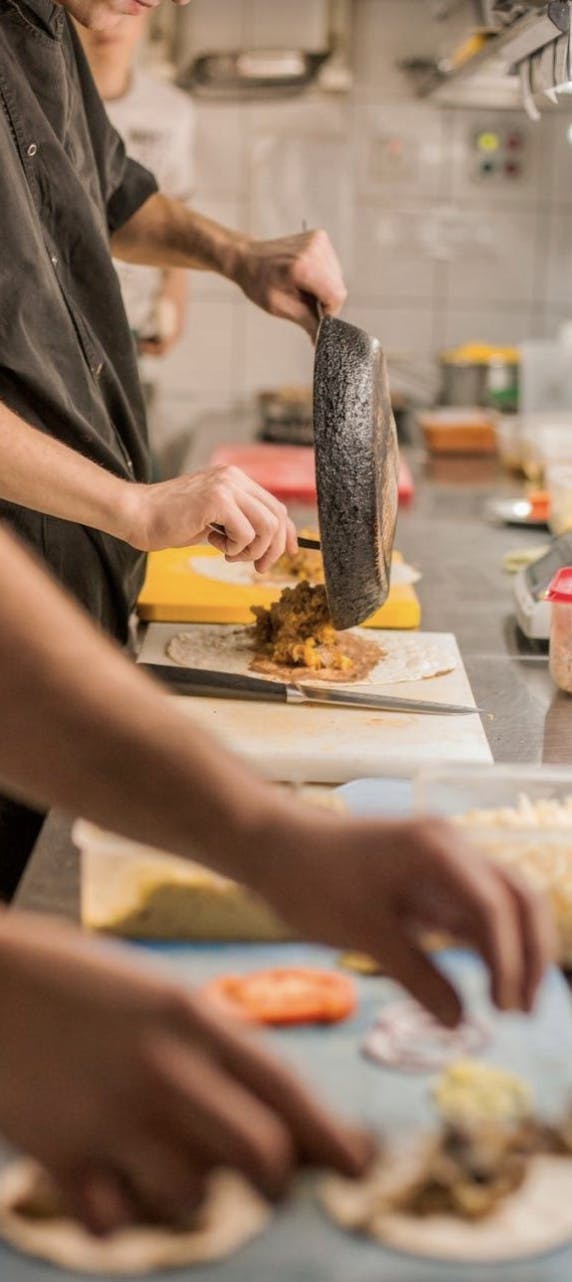Commercial kitchens vs. traditional restaurants: which delivers the best ROI?
Table of Contents
CloudKitchens
How many tacos can be delivered from a 1000sqft restaurant?
The same amount as a 200sqft ghost kitchen.
In today’s evolving food service landscape, restaurant operators and entrepreneurs are constantly evaluating the most profitable ways to run their businesses. One of the most debated comparisons is between commercial kitchens — also known as ghost kitchens — and traditional brick-and-mortar restaurants.
While traditional restaurants have long been the cornerstone of dining culture, commercial kitchens are emerging as a highly efficient and scalable model for modern food delivery and virtual dining.
This article explores the return on investment (ROI) of both models, examining startup costs, operational efficiencies, revenue potential, and long-term sustainability. Whether you’re starting a new concept or looking to pivot an existing operation, understanding the financial dynamics of each approach is crucial to your success.
Understanding ROI in the restaurant industry
Return on investment (ROI) is more than just a metric — it’s a powerful tool for gauging the financial health and long-term viability of a restaurant business. In the restaurant industry, ROI is typically calculated by subtracting the total investment from the net profit and then dividing that number by the total investment:
ROI = (Net Profit – Investment) / Investment
This equation helps owners and investors understand whether their money is being put to effective use and to what extent their ventures are profitable.
For example, if a restaurant invests $200,000 and earns a net profit of $50,000 annually, the ROI would be:
($50,000 / $200,000) = 0.25 or 25%
This means for every dollar invested, the business returns 25 cents in profit per year. While ROI benchmarks can vary, most restaurant owners want an ROI between 15% and 25% annually. Higher than that typically signifies strong performance, especially in a competitive industry like food service.
In traditional restaurant models, ROI can be significantly influenced by fluctuating foot traffic, variable overhead costs, and seasonality. For example, a location dependent on tourist traffic may experience excellent returns in peak seasons but suffer during off-peak times, skewing the average ROI.
Meanwhile, commercial kitchens offer a more streamlined path to profitability with fewer variables to manage. Because they often operate with reduced labor, lower rent, and minimal design or decor investments, commercial kitchens can start generating positive ROI faster.
Moreover, since commercial kitchens focus on delivery and online sales, data-driven performance metrics (like order volume, delivery radius, and repeat customer rate) can be closely monitored and optimized in real-time, contributing to improved ROI over time.
However, ROI is not just about cutting costs. Revenue generation, customer retention, brand scalability, and long-term operational sustainability all play a role. High ROI in either model requires a keen understanding of business metrics, agile marketing, and tight operational control. The more efficient your cost-to-profit ratio, the stronger your ROI will be — making it a key consideration for any restaurateur weighing commercial kitchens vs. traditional restaurants.
Read more: Ghost kitchen vs. traditional restaurant: which one is right for you?
Cost structures: commercial kitchens vs. traditional restaurants
Initial investment
Traditional restaurants often require significant upfront investments, including costs for prime real estate, interior design, dining areas, and extensive staff. These expenses can quickly add up, making it challenging for new restaurateurs to enter the market.
In contrast, commercial kitchens operate without a dine-in area, reducing the need for expensive real estate and front-of-house staff. This model allows for a lower initial investment, enabling entrepreneurs to launch food businesses with reduced financial risk.
Operational expenses
Traditional restaurants incur ongoing costs such as utilities for large spaces, maintenance of dining areas, and salaries for a full team of staff, including servers and hosts. These expenses can significantly impact the overall profitability.
Commercial kitchens streamline operations by focusing solely on food preparation and delivery. This focus reduces utility costs, minimizes staffing needs, and eliminates expenses associated with maintaining a dining area, leading to more efficient operations.
Read more: Reduce waste, save costs: essential food waste management strategies for restaurants
Revenue generation and scalability
Traditional restaurants
Traditional restaurants generate revenue through in-house dining experiences, which can be limited by seating capacity and location. While they can build strong local customer bases, scaling requires opening additional locations, each with its own set of high costs and risks.
Commercial kitchens
Commercial kitchens leverage online delivery platforms to reach a broader customer base without geographical limitations. This model allows for rapid scalability, as new locations can be established with lower costs and faster setup times. Additionally, operators can run multiple brands from a single kitchen, maximizing revenue streams.
Profit margins and ROI
Due to lower overhead costs and streamlined operations, commercial kitchens can often achieve higher profit margins compared to traditional restaurants. The reduced financial burden allows for a quicker return on investment, making this model attractive for entrepreneurs seeking efficient profitability.
Traditional restaurants, while offering unique dining experiences, face higher operational costs that can erode profit margins. Achieving a desirable ROI requires careful management of expenses and consistent customer turnout, which can be influenced by factors such as location and market competition.
Flexibility and market adaptation
Commercial kitchens offer greater flexibility in adapting to market trends. Operators can quickly modify menus, launch new concepts, or adjust operations based on customer feedback and demand. This agility is particularly beneficial in the fast-paced food industry, where consumer preferences can change rapidly.
Traditional restaurants may face challenges in adapting due to fixed menus, established brand identities, and the complexities of changing physical spaces. Implementing significant changes can be time-consuming and costly, potentially hindering responsiveness to market shifts.
Read more: Restaurant financing & loans guide
Customer experience and brand building
Traditional restaurants excel in providing in-person dining experiences, allowing for direct customer interaction and ambiance that can enhance brand loyalty. These experiences contribute to building a strong brand presence and customer relationships.
Commercial kitchens, operating without a physical dining space, rely on digital platforms for customer engagement. While this limits face-to-face interaction, it offers opportunities to build brand recognition through online marketing, social media, and consistent delivery service.
Risk management and business resilience
The lower financial commitment required for commercial kitchens reduces the risk associated with launching a new food business. This model allows entrepreneurs to test concepts and adapt quickly without the burden of significant debt or long-term leases.
Traditional restaurants, with higher fixed costs and longer setup times, face greater risks, especially in volatile markets or during economic downturns. The inability to pivot quickly can impact long-term sustainability.
Read more: Top strategies to increase customer retention for your restaurant or delivery service
Elevate your food business with CloudKitchens
When comparing the ROI of commercial kitchens and traditional restaurants, commercial kitchens offer a compelling model for modern food entrepreneurs. With lower startup costs, higher scalability, and greater operational efficiency, they present an opportunity for quicker and more sustainable returns on investment.
Traditional restaurants, while offering unique dining experiences, require significant investments and face higher operational challenges. Success in this model depends on various factors, including location, market demand, and effective management.
Ready to maximize your ROI and streamline your operations? CloudKitchens provides state-of-the-art commercial kitchen spaces designed to help you launch and grow your food business efficiently. With our support, you can focus on what you do best — creating delicious food!
Discover how CloudKitchens can transform your culinary vision into a profitable reality!
DISCLAIMER: This information is provided for general informational purposes only and the content does not constitute an endorsement. CloudKitchens does not warrant the accuracy or completeness of any information, text, images/graphics, links, or other content contained within the blog content. We recommend that you consult with financial, legal, and business professionals for advice specific to your situation.
More insights & stories
There’s more where that came from.
Get in the know and check out our additional insights


